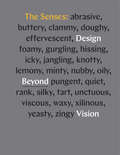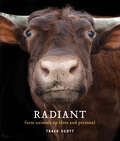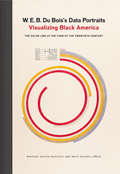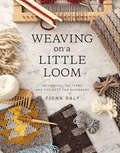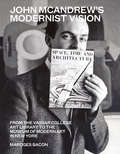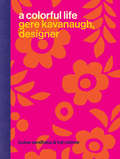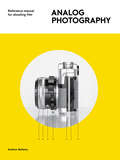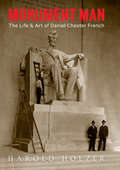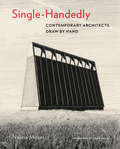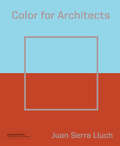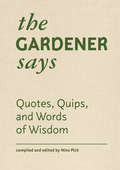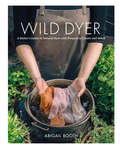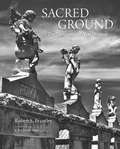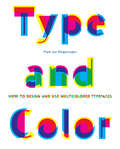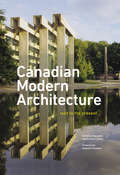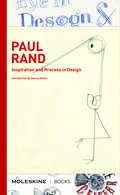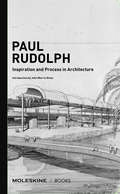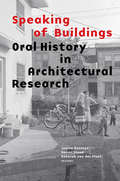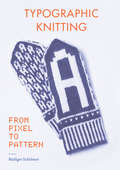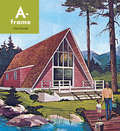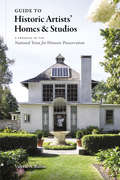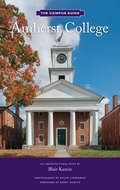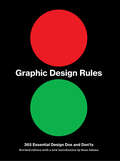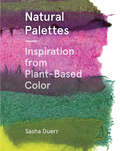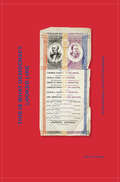- Table View
- List View
The Senses: Design Beyond Vision
by Ellen Lupton Andrea LippsA powerful reminder to anyone who thinks design is primarily a visual pursuit, The Senses accompanies a major exhibition at the Cooper-Hewitt Smithsonian Design Museum that explores how space, materials, sound, and light affect the mind and body. Learn how contemporary designers, including Petra Blaisse, Bruce Mau, Malin+Goetz and many others, engage sensory experience. Multisensory design can solve problems and enhance life for everyone, including those with sensory disabilities. Featuring thematic essays on topics ranging from design for the table to tactile graphics, tactile sound, and visualizing the senses, this book is a call to action for multisensory design practice. The Senses: Design Beyond Vision is mandatory reading for students and professionals working in diverse fields, including products, interiors, graphics, interaction, sound, animation, and data visualization, or anyone seeking the widest possible understanding of design.The book, designed by David Genco with Ellen Lupton, is edited by Lupton and curator Andrea Lipps. Includes essays by Lupton, Lipps, Christopher Brosius, Hansel Bauman, Karen Kraskow, Binglei Yan, and Simon Kinnear.
Radiant: Farm Animals Up Close and Personal
by Traer ScottGregarious or shy, curious or placid, playful or retiring, all the animals in Traer Scott's newest collection have one thing in common: a sparkling personality! This whimsical, soulful, and personal photo collection focuses on the lives of the farm animals we often take for granted. Scott introduces us to barnyard animals both familiar and lesser known, from cows, pigs, sheep, and chickens to Dolly the wooly llama, Bianca the Sicilian miniature donkey, Percy the Indian peafowl, and Justice the yak. Some of the animals are kept as pets; others are denizens of farm sanctuaries that Scott has visited. She shares her anecdotes about a Texas longhorn steer whose best friends are a trio of goats, a turkey who likes to snack on grapes and watermelon, and many others. Lively captions provide information on each breed, to round out this enchanting tribute to our four-legged (and winged) friends from the farm.
W. E. B. Du Bois's Data Portraits: #N/A
by Britt Rusert The W.E.B. Du Bois Center at the University of Massachusetts Amherst Whitney Battle-BaptisteThe colorful charts, graphs, and maps presented at the 1900 Paris Exposition by famed sociologist and black rights activist W. E. B. Du Bois offered a view into the lives of black Americans, conveying a literal and figurative representation of "the color line." From advances in education to the lingering effects of slavery, these prophetic infographics —beautiful in design and powerful in content—make visible a wide spectrum of black experience.W. E. B. Du Bois's Data Portraits collects the complete set of graphics in full color for the first time, making their insights and innovations available to a contemporary imagination. As Maria Popova wrote, these data portraits shaped how "Du Bois himself thought about sociology, informing the ideas with which he set the world ablaze three years later in The Souls of Black Folk."
Weaving on a Little Loom: Techniques, Patterns, and Projects for Beginners
by Fiona DalyWeaving on a Little Loom teaches readers everything they need to know to start small-frame loom weaving, an easy and inexpensive craft that can be done at home. From setting up the loom to finishing a project, this book covers both basic and more advanced techniques, with an introduction to creating patterns such as basket and bird's eye weaves, rib, twill, and herringbone. With clear instruction and beautiful illustrative photographs, step-by-step tutorials guide you through designing and creating five contemporary woven projects—including table placemats, wall hangings, and a tote bag—all made with natural, environmentally friendly materials.
John McAndrew's Modernist Vision: #N/A
by Mardges BaconJohn McAndrew's Modernist Vision tells the compelling story of the architect, scholar, and curator John McAndrew, who played a key role in redefining modernism in the United States from the 1930s onward. The designer of the Vassar College Art Library—arguably the first modern interior on a college campus—and the curator of architecture at the Museum of Modern Art in New York from 1937 to 1941, McAndrew was instrumental in creating a distinct and innovative aesthetic that bridged the European modernist lineage and American regional vernacular. Providing a fascinating glimpse into McAndrew's life, his associations with important architects and artists, and the historical context that shaped his work, this book is a thoroughly researched testament to a man who left a powerful mark on the evolution of American architecture.
A Colorful Life: Gere Kavanaugh, Designer
by Louise Sandhaus Kat CatmurThe designer Gere Kavanaugh is an irrepressible force of nature who epitomized the craft and folk vibe of the '60s and '70s California design scene and remains a larger-than-life personality today. Raised in Memphis, Tennessee, Kavanaugh became in 1952 only the third woman to earn a degree in Cranbrook Academy of Art's design program. After successful stints as one of GM's so-called Damsels of Design and as director of interiors for Victor Gruen's architecture and planning firm, she opened Gere Kavanaugh/Designs. There, Kavanaugh put her unique stamp on textiles, furniture, toys, graphics, store and restaurant interiors, holiday decor, housewares, and public art—even designing and curating exhibitions. But perhaps her most enduring project has been the joyful, open-ended, ongoing experiment of her own lifestyle and homes, a dream of color and handcraft. Kavanaugh was awarded the AIGA Medal in 2016, recognizing her "prodigious and polymathic approach to design."
Analog Photography: Reference Manual for Shooting Film
by Andrew BellamyAttracted by the image quality, the tactile joy of a finely made camera, and the affordable prices of vintage equipment, photographers around the world are rediscovering the joys of manual photography. This comprehensive guide to shooting film photography covers all the bases, from setting up a camera through film processing. In a convenient format, filled with diagrams, examples, and illustrations, Analog Photography is a portable reference tool for neophytes and experienced photographers alike. With an irresistible package inspired by the aesthetics of vintage user manuals, this is "a great-looking publication and a fantastic place from which to start, or rekindle, a journey into film photography" (Creative Review).
Monument Man: The Life and Art of Daniel Chester French
by Harold HolzerThe artist who created the statue for the Lincoln Memorial, John Harvard in Harvard Yard, and The Minute Man in Concord, Massachusetts, Daniel Chester French (1850–1931) is America's best-known sculptor of public monuments. Monument Man is the first comprehensive biography of this fascinating figure and his illustrious career. <p><p> Full of rich detail and beautiful archival photographs, Monument Man is a nuanced study of a preeminent artist whose evolution ran parallel to, and deeply influenced, the development of American sculpture, iconography, and historical memory. <p> Monument Man was specially commissioned by Chesterwood / National Trust for Historic Preservation. The release will coincide with the fiftieth anniversary of the opening of Chesterwood, his country home and studio, as a public site and with a major renovation of the Lincoln Memorial. The book includes a comprehensive geographical guide to French's public work.
Single-Handedly: Contemporary Architects Draw by Hand
by Nalina MosesPart of the generation of architects who were trained to draw both by hand and with digital tools, Nalina Moses recently returned to hand drawing. Finding it to be direct, pleasurable, and intuitive, she wondered whether other architects felt the same way. Single-Handedly is the result of this inquiry. An inspiring collection of 220 hand drawings by more than forty emerging architects and well-known practitioners from around the world, this book explores the reasons they draw by hand and gives testimony to the continued vitality of hand drawing in architecture. The powerful yet intimate drawings carry larger propositions about materials, space, and construction, and each one stands on its own as a work of art.
Color for Architects (Architecture Brief)
by Juan Serra LluchAs far back as the earliest Greek temples, color has been an integral part of architecture but also one of its least understood elements. Color theory is rarely taught in architecture schools, leaving architects to puzzle out the hows and whys of which colors to select and how they interact, complement, or clash. Color for Architects is profusely illustrated and provides a clear, concise primer on color for designers of every kind. This latest volume in our Architecture Briefs series combines the theoretical and practical, providing the basics on which to build a fuller mastery of this essential component of design. A wealth of built examples, exercises, and activities allows students to apply their learning of color to real-world situations.
The Gardener Says: Quotes, Quips, and Words of Wisdom (Quotes, Quips, and Words of Wisdom)
by Nina PickThe Gardener Says invites readers to a festive garden party where guests ranging from Gertrude Jekyll and Henry David Thoreau, to Michelle Obama and Michael Pollan share their insights and words of inspiration. Ranging from the humorous to the poignant, these quotes from gardeners, poets, philosophers, and landscape designers highlight both the joys and challenges of gardening—the exhaustion at the end of a long day's work, the satisfaction of seeing a flower blossom, the peace and happiness of time spent in quiet contemplation. A delightful hobby, a potent tool for ecological and social transformation, and a crucial reminder of our place in nature, gardening is, in the words of Mirabel Osler, the one occupation where "if you were to creep up behind someone at their work, you would find them smiling."
The Wild Dyer: A Maker's Guide to Natural Dyes with Beautiful Projects to create and stitch
by Abigail BoothFabrics colored with natural dyes have a beauty and subtlety all of their own. Onion and avocado skins, chamomile and birch bark, and nettles and acorns can produce lovely, ethereal colors and effects. The Wild Dyer demystifies this ecoconscious art, focusing on foraging and growing dying materials; repurposing kitchen trimmings; making and using long-lasting dyes; and creating stitched projects. Workspace setup, equipment, and fabric choices and care are all discussed. Beautiful photographs and easy-to-follow instructions illustrate how to make fifteen exquisite household items, from a drawstring bag to a gardener's smock and a reversible patchwork blanket. The Wild Dyer is a complete guide for both beginners and experienced artists seeking to expand their knowledge of this increasingly popular craft.
Sacred Ground: The Cemeteries of New Orleans
by Robert S. BrantleySacred Ground is a sumptuous photographic portrait of New Orleans's legendary cemeteries. Robert S. Brantley celebrates the otherworldly landscapes, intricate ironwork, evocative memorials, and stately monuments as vibrant sites of remembrance. New Orleans history is further revealed through biographies of twenty individuals whose grave sites are among those featured, including entrepreneurs, celebrated musicians, a world-class violin maker, an ex-slave turned minister, a ship's captain, and a young soldier felled by Spanish flu while in basic training for World War I. The rich duotone photographs, organized by cemetery, are followed by an index identifying the tombs and their iconography; an introduction by S. Frederick Starr provides background on New Orleans cemetery history, culture, and burial customs. Sacred Ground provides a stunning exploration of the traditions born of New Orleans's unique religious, cultural, and ethnic diversity.
Type & Color: How to Design and Use Multicolored Typefaces
by Mark van WageningenTo create his award-winning multicolored typefaces, Mark van Wageningen first returned to the past for his research: wood-type printing. His subsequent form and color studies led to a series of popular digital typefaces and awards for typographic excellence from the Type Directors Club. In Type & Color, the pioneering typographic designer provides all the tools you will need to participate in the hottest typography trend: designing with multicolored fonts. This manual, aimed at a broad spectrum of graphic design professionals, offers analyses of chromatic type specimens, instructions for multilayer type design, and applications across a range of print and digital media. From display fonts to running text, discover how color can give words expressive new possibilities.
Canadian Modern Architecture: A Fifty Year Retrospective (1967-2017)
by Elsa Lam Graham LiveseyCanada's most distinguished architectural critics and scholars offer fresh insights into the country's unique modern and contemporary architecture. Beginning with the nation's centennial and Expo 67 in Montreal, this fifty-year retrospective covers the defining of national institutions and movements, how Canadian architects interpreted major external trends, regional and indigenous architectural tendencies, and the influence of architects in Canada's three largest cities — Toronto, Montreal, and Vancouver. Co-published with Canadian Architect, this comprehensive reference book is extensively illustrated and includes fifteen specially commissioned essays.
Paul Rand: Inspiration & Process in Design (Inspiration & Process)
by Steven Heller Eugenia BellBest-known for his corporate brand logos and art direction, Paul Rand (1914–1986) transformed commercial art from craft to profession, introduced European design standards to American commercial art, influenced the look of advertising and book design, and altered the ways in which major corporations including IBM, UPS, and Westinghouse did business. His adherence to a strict design form in his work for corporate clients was balanced by a playful side , captured in this spirited collection of literal (and figural) back-of-the-envelope sketches, doodles, notes, and imaginative sparks that later found their full form in his children's books, logos, and personal work.
Paul Rudolph: Inspiration & Process in Architecture (Inspiration & Process)
by John Morris Dixon Eugenia BellPaul Rudolph (1918–1997) authored some of Modernism's most powerful designs and served as an influential educator while chair of Yale's School of Architecture. His early residential work in Sarasota, Florida, garnered international attention, and his later exploration of Brutalist materials nd forms, most famously embodied in his Yale Art & Architecture Building (1963), earned Rudolph both notoriety and acclaim.Many of the dynamic drawings included in this collection — selected from the architect's archive housed in the Library of Congress — illustrate his highly emotive hand and deft drafting skill. They include his designs for Tuskegee University Chapel, Interama, Lower Manhattan Expressway, his analysis of Mies van der Rohe's Barcelona Pavilion, and his own inventive penthouse on Beekman Place in New York City. A lively Rudolph interview, conducted in 1986, and a newly commissioned introductory essay provide context for the drawings.
Speaking of Buildings: Oral History in Architectural Research
by Janina Gosseye Naomi Stead Deborah van der PlaatBy and large, architectural historians use texts, drawings, and photographs to craft their narratives. Oral testimony from those who actually occupy or construct buildings is rarely taken as seriously. Speaking of Buildings offers a rebuttal, theorizing the radical potential of a methodology that has historically been cast as unreliable. Essays by an international group of scholars look at varied topics, from the role of gossip in undermining masculine narratives in architecture to workers' accounts of building with cement in midcentury London to a sound art piece created by oral testimonies from Los Angeles public housing residents. In sum, the authors call for a renewed form of listening to enrich our understanding of what buildings are, what they do, and what they mean to people.
Typographic Knitting: From Pixel to Pattern
by Rudiger SchlomerLearn to knit a variety of typefaces modeled on digital designs by well-known type foundries including Emigre, Lineto, and Typotheque, and emblazon your hats, scarves, and sweaters with smartly designed monograms, letters, or words. Beginning with knitting basics, tips, and resources, and progressing through more advanced techniques, Typographic Knitting provides a systematic introduction on how to construct a variety of letter designs using different knitting techniques. This book bridges the gap between craft and design in a new way, and will delight typography connoisseurs, avid knitters, and makers looking for a novel medium.
A-Frame: Revised Edition
by Chad RandlThe heyday of the national A-frame craze saw tens of thousands of these easy and affordable structures built as vacation homes, roadside restaurants, churches, and even pet stores. A-frame chronicles America's love affair with the A-frame, from postwar getaway to its recent revival among designers and DIYers. In a fascinating look at this architectural phenomenon, Chad Randl tells the story of the triangle house, from prehistoric Japan to its lifestyle-changing prime in the 1960s as a symbol of play, leisure, and outdoor living. Part architectural history and part cultural exploration, the book documents every aspect of A-frame living with cartoons, ads, high-style and do-it-yourself examples, family snapshots, and an appendix with a complete set of blueprints in case you want to build your own.
A Guide to Historic Artists' Home and Studios
by Valerie BalintFrom the desert vistas of Georgia O'Keeffe's New Mexico ranch to Jackson Pollock and Lee Krasner's Hamptons cottage, step into the homes and studios of illustrious American artists and witness creativity in the making. Celebrating the twentieth anniversary of the Historic Artists' Homes and Studios program of the National Trust for Historic Preservation, this is the first guidebook to the forty-four site museums in the network, located across all regions of the United States and all open to the public. The guide conveys each artist's visual legacy and sets each site in the context of its architecture and landscape, which often were designed by the artists themselves.Through portraits, artwork, and site photos, discover the powerful influence of place on American greats such as Andrew Wyeth, Grant Wood, Winslow Homer, and Donald Judd as well as lesser-known but equally creative figures who made important contributions to cultural history—photographer Alice Austen and muralist Clementine Hunter among them.
Amherst College: The Campus Guide (The Campus Guide)
by Blair KaminAmherst College: The Campus Guide is an architectural tour of one of North America's most prestigious liberal arts colleges. Founded in Western Massachusetts some two hundred years ago, the one thousand-acre campus is a living museum of architectural history, bearing the imprint of distinguished firms in architecture and landscape architecture: Frederick Law Olmsted; McKim, Mead & White; Benjamin Thompson; Edward Larrabee Barnes; Shepley Bulfinch; and Michael Van Valkenburgh. Organized as a series of six walks, the guide interweaves the history of the college with the story of the campus's development. Newly commissioned photographs and a hand drawn pocket map enhance this engaging journey through Amherst's architecture, landscape, interior design, and sculpture.
Graphic Design Rules: 365 Essential Design Dos and Don'ts
by Tony Seddon Sean Adams Peter Dawson John FosterDON'T use comic sans (except ironically!) but DO worship the classic typefaces like Helvetica and Garamond. Graphic Design Rules is a handy guide for professional graphic designers, students, and laymen who incorporate graphic design into their job or small business. Packed with practical advice, this spirited collection of design dos and don'ts takes readers through 365 rules like knowing when to use a modular grid—and when to throw the grid out the window. All designers will appreciate tips and lessons from these highly accomplished authors, who draw on years of experience to help you create good design.
Natural Palettes: Inspirational Plant-Based Color Systems
by Sasha Duerr“The plant-lover’s alternative to the Pantone color guide.”—Julia Sherman, creator of Salad for President Renowned natural dyer, artist, and educator Sasha Duerr envisions a new age of fresh, modern color palettes, drawing from our original source of inspiration and ingredients—the natural world around us. This innovative plant-based color guide includes twenty-five palettes with five hundred natural color swatches, providing a bounty of ideas for sustainable fashion, textiles, fine art, floral design, food, medicine, gardening, interior design, and other creative disciplines. Bring the healing power of forest bathing into your home with a palette of spruce cones, pine needles, and balsam branches. Move past Pantone and embrace the natural balance of a pollinator palette with Hopi sunflower, red poppy, echinacea, and scabiosa.Duerr complements her palettes with illuminating reflections on connections between color and landscape, the healing properties of medicinal plants, the ways food and floral waste can be regenerated to enhance lifestyle experiences, the ecological benefits of using natural colors, and more. You may never view color—or the plants that surround us—the same way again.
This is What Democracy Looked Like: A Visual History of the Printed Ballot
by Alicia Yin ChengThis Is What Democracy Looked Like, the first illustrated history of printed ballot design, illuminates the noble but often flawed process at the heart of our democracy. An exploration and celebration of US ballots from the nineteenth and early twentieth centuries, this visual history reveals unregulated, outlandish, and, at times, absurd designs that reflect the explosive growth and changing face of the voting public. The ballots offer insight into a pivotal time in American history—a period of tectonic shifts in the electoral system—fraught with electoral fraud, disenfranchisement, scams, and skullduggery, as parties printed their own tickets and voters risked their lives going to the polls.
